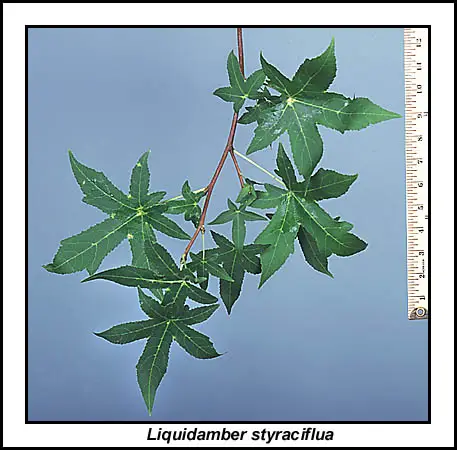American Sweet gum tree
The American sweet gum tree is also known as the red gum, star-leafed gum, gum tree and alligator wood. Sweet gum is found in the eastern part of the United States and it prefers wet acidic soils such as those of swamps, streams or ponds. Sweet gum is a pioneer species, being one of the first to grow after fires burn the area.
These trees are large, often growing to one hundred fifty feet in height and their dark green bitter leaves are star shaped, turning red, yellow, orange or purple in the fall. They are often compared to maple trees as for their beauty. The fruit is enclosed in a sticky ball that often causes people to sprain their ankles if it is left on the lawns, as is attested to by some of the common names; sticker ball, gum ball, monkey ball and several others.

The sweet gum tree has very distinctive star shaped leaves
The name alligator bark comes from the appearance of the rough, ridged gray bark which grows sideways on the twigs and branches.
Sweet gum has an interesting history, in the mid seventeenth century, a description of the tree was written by the Spanish historian, F. Hernandez, in which he writes of a large tree that produces liquid amber. In 1681, John Banister collected specimens for Bishop Compton who then planted it in Fulham, adding a rich beautiful tree to the collection. Some of the countries it has been introduced to are Argentina, Brazil, South Africa, Uruguay and Europe.
The sweet gum wood is used in fine interior woodworking, flooring, veneer, but is too prone to the ravages of decay to use for timber. The gum resin is used for mixing with tobacco and being smoked by the Mexican emperors and is also being used in the dying of men’s gloves. Early pioneers scraped the resin from the tree and used it for a chewing gum.
In the April 5th issue of Science News, http://www.sciencedaily.com/releases/2006/04/060405234139.htm, a substance from the sweet gum tree could prove advantageous for manufacturing a drug to combat bird flu. The fruit of the sweet gum is where the most important part of the shikimic acid is located.
The main source for the acid now is from the Chinese star anise, which is rapidly becoming hard to find. If enough of this substance can be found, it would be of great benefit to many of the world’s inhabitants.




Like the tree with such good shade but the gum balls are a real pain. What can be done to keep this in check other than constant raking? HELP
Used this site for a research project. Lifesaver! THANKS!